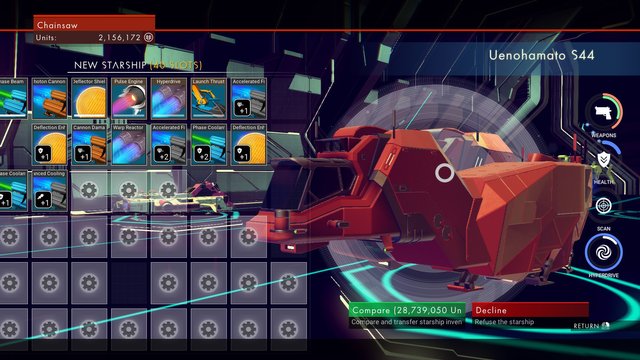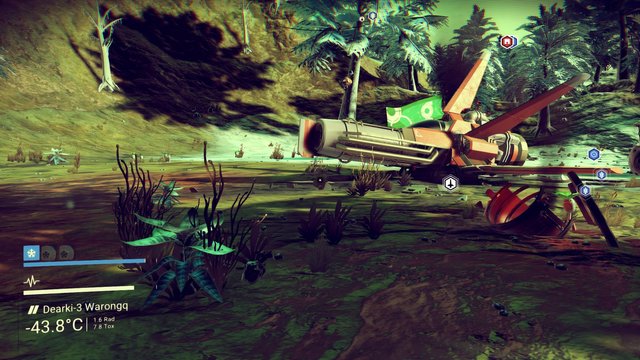No Man's Sky - The Quest to a 48 Slot Starship - Comparing Discovering Crashed Starships vs Buying New
In this article we will discuss the two main approaches for upgrading your starship size within No Man's Sky. Whatever your motivation to upgrade - hold more inventory, earn more money, be more prepared for disasters - you have two main paths towards finding larger ships.
If you would like to develop and evolve your own personal strategy for how to handle this, read no further. The remainder of this article will analyze the two approaches, and share the conclusions I've come to. The end result was a NMS experience that was enjoyable while also efficient. We will look at the two approaches and add a bit of formalization to them. Then we'll compare them, and try to come up with a strategy that helps one realize when it is optimal to use one versus another.
Approach 1 - Purchasing Larger Ships

The cost of starships is not linear. You may have gotten at 20 Slot ship for under 1 Million Units. A 40 Slot will not be 2 Million - closer to 30 Million.
Prices vary from ship to ship based at least on size and installed units. It may also vary based on ship style, trader alliance. Prices have gotten more expensive as one moves closer to the center of the Galaxy, but this is likely due to better-installed equipment than a simple cost increase based on distance.
When you purchase a ship, you are effectively giving up your previous ship, then gaining the new ship. When you do this, the new ship can be of any size. When you have bought your new ship, you gain X slots in your ship, at the cost of Y units. Based on your approximate hourly Unit-earning rate, this lets you know how many Slots Gained/Hour this approach yields.
Approach 2 - Discovering Larger Ships

When you discover new ships, the size of the discovered ship does not behave as Space Station starship sizes. Along the way to a 48 slot ship, every ship you discover will be 1 slot larger or 1 slot smaller than the current ship you have.
When you discover a ship, you are effectively giving up your previous ship, then gaining the new ship. When you do this, the new ship will be 1 slot larger. When you upgrade to your new ship, you gain 1 slots in your ship, at the cost of Y time. Based on your approximate hourly ship-discovering rate, this lets you know how many Slots Gained/Hour this approach yields.
Determining Which Approach to Use - A Comparison
Most generally, purchasing a new starship will be most beneficial early on. At some point, it will become more beneficial to upgrade through discovery. This is based on using no exploits - if you use any still-existant exploits to earn more money than the game intends, then it is net beneficial to purchase the starship. Earning at the intended gamerate, it seems forcibly beneficial to transition to ship discovery somewhere along the curve. We'll walk through two examples to illustrate this - one from early game, the other from late game.
Example 1 (Early Game)
Bob begins, and has a 12 slot starship. At this point in the game (brand new), let's be generous and say he can earn $250,000/hour.
Approach 1 (Buying) -
He could upgrade to a 24 slot starship for $3,000,000 units. This would equal 12 slots for 3 million, or $250,000/slot.
Bob could gain slots at 1 Slot / Hour by buying a new starship.
Approach 2 (Discovering) -
He could discover 12 new starship improvements. With optimal play, on the average Bob will discover a new, larger ship at the rate of 1 per Hour.
Bob could gain slots at 1 Slot / Hour by discovering new ships.
Example 2 (Late Game)
Bob has a 36 slot starship. It is later in the game. Without using exploits, let's say he can something like $2,000,000 Units/hour. He wishes to get the 48 slot ship (we are using the same 12-slot increase as in the past example).
Approach 1 (Buying) -
He could upgrade to a 48 slot starship for maybe $72,000,000 units. This would equal 12 slots for 72 million, or $6,000,000/slot.
Bob could gain slots at 1 Slot / 3 Hours, or 0.33 Slots/Hour by buying a new starship.
Approach 2 (Discovering) -
He could discover 12 new starship improvements. With optimal play, on the average Bob will discover a new, larger ship at the rate of 1 per Hour.
Bob could gain slots at 1 Slot / Hour by discovering new ships.
Conclusions
In Example 1, we see that it would not matter which approach Bob used. Of course, if he could earn Units just a tiny bit faster than $250,000 Units/hr, that would be the faster approach. If he could discover ship upgrades faster than 1 per hour, that would be the faster approach.
In Example 2, we see that it would take Bob 36 hours using the Buying approach, but only 12 hours using the discovery approach. By this stage of the game, even when batching size upgrades, it is 3 times more efficient to use ship discovery.
As you can see from the conservative examples above, discovering becomes increasingly efficient over purchasing. This is true even when batching, or skipping sizes. (When going the purchasing route, you always want to jump up as many sizes as possible at once, as you get no value for your previous ship.) If we ran through an example comparing the cost of upgrading 1 ship size through purchase versus discovery, it would be an absolute blowout.
Related Concepts - Diving Deeper
Here are a few more concepts related to ship upgrading. If there is interest, I will write separate articles going into far greater detail about efficient (and honest) methods to earn money or discover crashed ships.
-How to Efficiently Earn Units
-How to Efficiently Discover Crashed Ships
-Baseline odds for the ship being larger versus smaller seem to be 50%. I have not yet verified if there is a behind-the-scenes bias when your current starship size is smaller than an 'expected size'. I point this out as a possibility because, on two occasions, when I began upgrading after a long lapse, I experienced a string of 3 and 5 upgrades in a row, with no smaller-ships. This could also be luck.
-Kind of ship has not just a planetary but a Regional bias. You may notice that while on a planet, you will enounter many of the same kind of ship. This same notion holds true at space stations. Ships tend to have common styles not just within a planet, but at least a solar system. It seems there is an influence that extends at least into the Region which holds multiple solar systems. In short, if you are looking for the perfect style ship once you are at your desired size, you may need to jump into a new region before you find success.
Remember - No Man's Sky is a Sandbox Game
Analysis demands cold, hard, absolute conclusions. Try to remember one thing. The analysis above answers one particular question - what is the most efficient way to upgrade my ship? Many of us are not solving for optimal efficiency, but enjoyment. Remember that at the end of the day, we all get to play No Man's Sky in whatever way we choose. For some, efficiency be damned. For others, it is the only way.
If you'd like more articles like this, follow me! More NMS articles will follow. Have a topic you'd like covered? Comment below. I would love to dive into greater detail on the specifics of efficiently earning units, efficiently discovering the crashed ships, or whatever else you may be interested in.
How about an article giving tips on how to tag all the different animals on a planet? As I understand it you can get hundreds of thousands of credits if you find them all.
I would love to! There are definitely a handful of tips and tricks that can reduce the average time. My first planet probably took 10 hours, the 10th no more than 2.
I'll add that to my article list immediately. Thanks!